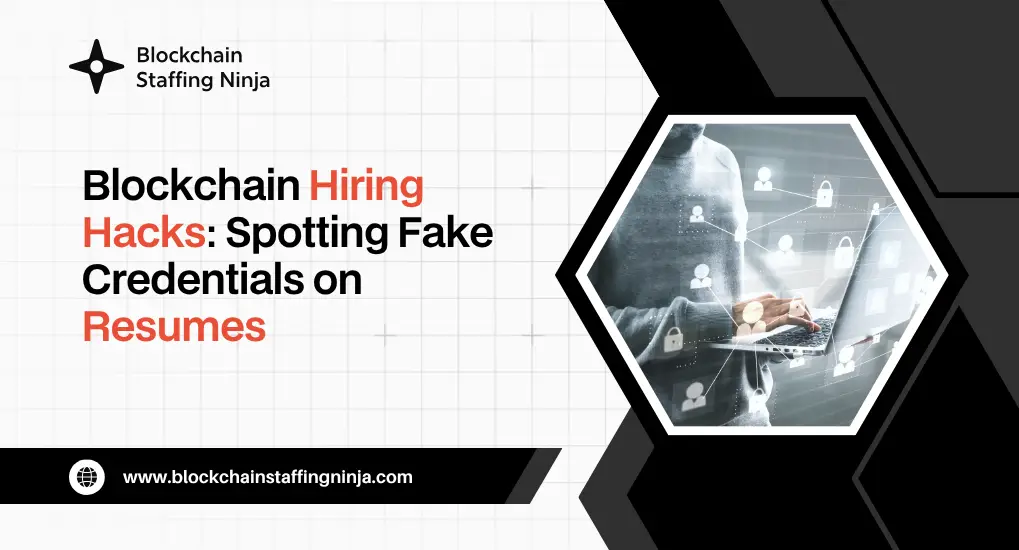There is a hiring boom in the blockchain industry as applicants dash to join the industry. However, a booming industry brings increased fraudulent resumes as workers exaggerate their qualifications to land roles. And recognising phoney qualifications is key, to make sure businesses are only bringing in qualified people who can maintain the quality of their projects. So, to assist employers in building trustworthy teams in a competitive landscape and in Blockchain fraud prevention, this article provides practical tips and verification methods to detect fake credentials in blockchain resumes.
Why Do Candidates Use Fake Credentials?
Before we cover detection, it helps to understand from the perspective of a candidate — why resume falsification even occurs in the first place.
Bridging Employment Gaps
Certain candidates fabricate job experiences to cover gaps in their employment history, forming an unbroken work record. Hiring managers should dive deep into timelines for inconsistencies and vague details that don’t match up.
Underqualified
Applicants may embellish or lie about degrees and certifications to qualify for blockchain jobs. The trick has led companies to check educational credentials with institutions.
Pressure from a Competitive Industry
Given blockchain’s rapidly changing dynamics, candidates may embellish skills or previous positions to gain an edge over competitors. Recruiters need to vet claims to confirm applicants truly have the skills they promote.
Common Red Flags in Blockchain Resumes
Hiring managers should look out for certain red flags of fake credentials. Each red flag is explained in detail in this section.
Inconsistent Job Timelines
When you make up your own job history, it’s easy to mess up overlapping dates or leave large unexplained gaps. Recruiters can cross-check with employers or references.
Fake or Unverified Degrees
Some candidates will claim degrees from nonexistent or unaccredited colleges. A quick check with institutions or accreditation bodies reveals these untruths.
Inflated Job Titles and Responsibilities
Some candidates picture themselves in senior blockchain positions that weren’t theirs. Confirm their actual roles; past employers could be contacted or connected on LinkedIn.
Vague or Overgeneralized Experience
Unless data and metrics are on their resumes, vagueness can be a mask for boisterous exaggeration. Managers should ask for portfolios or concrete evidence to verify claims.
How to Verify a Candidate’s Credentials
After spotting red flags, the next step is to verify a candidate’s background. This part should include Blockchain recruitment tips with digital methods as well as Blockchain professional verification techniques that are manual.
- Digital Verification Tools: Applicant tracking systems (ATS) flag discrepancies, while background check services and blockchain-based platforms verify authenticity through tamper-proof records.
- Previous Employers: Contact them directly using authentic contact details to verify job titles and dates, circumventing fake references.
- Verify Degrees: Confirm degrees and certifications listed on resumes with educational institutions or through verification databases.
- Reference Checks: Ask the candidate for relevant references and specific questions about what they did in the role, e.g., What blockchain projects did they lead? —to confirm skills and experience beyond vague flattery.
How Blockchain Itself Can Help in Verification
Due to its security and transparency, blockchain technology is an excellent tool for credential verification and the Blockchain hiring process. This section should describe how employers can validate resumes using blockchain. The transparent and secure nature of blockchain makes it a great resource for credential verification.
- Immutable Records: Certificates stored on a blockchain and work histories cannot be changed, providing employers with proof of a candidate’s qualifications that comes from a trusted source.
- Decentralized Verification: Instead of needing to contact different universities or employers to confirm credentials, universities, employers, and certification bodies can upload them to a blockchain, where they can be instantly and verifiably have them validated by multiple parties without a central gatekeeper, making validation easy.
Blockchain Hiring Best Practices for Employers to Avoid Fake Credentials
Companies should thus follow a robust verification process to ensure that only qualified candidates get hired. Having a framework for this process will ensure that only the best candidates are hired.
- Set a Verification Policy: Treat every candidate the same; perform background checks and call references. Spot discrepancies early and fairly.
- Implement Skills-Based assessment: Provide coding riddles or blockchain-in particular tasks to verify their subject matter proficiency and to lessen dependence on potential fictitious resumes.
- Train Hiring Teams: Arm your recruiters with skills to detect fraud, such as identifying timeline discrepancies or verifying certifications, in order to stay one step ahead of deceptive strategies.
- Follow Legal Guidelines: Ensure checks are done ethically, stay compliant with privacy laws such as GDPR or CCPA, and communicate transparently about the process to candidates.
Conclusion
Detecting fake credentials in blockchain hiring is important to protect your team’s quality and your company’s integrity. As expertise becomes the ultimate currency to achieve success, employers need to minimize any risks of credential fraud in blockchain with proper verification that can be ensured through background checks and leveraging blockchain tools. To avoid hiring unqualified candidates, recruiters need to screen resumes thoroughly, verify qualifications, and authenticate experience. These measures guarantee that only qualified professionals enter the field and are a significant step forward in ensuring trust and excellence in the rapidly growing industry.
 blockchain-staffing-ninja
blockchain-staffing-ninja